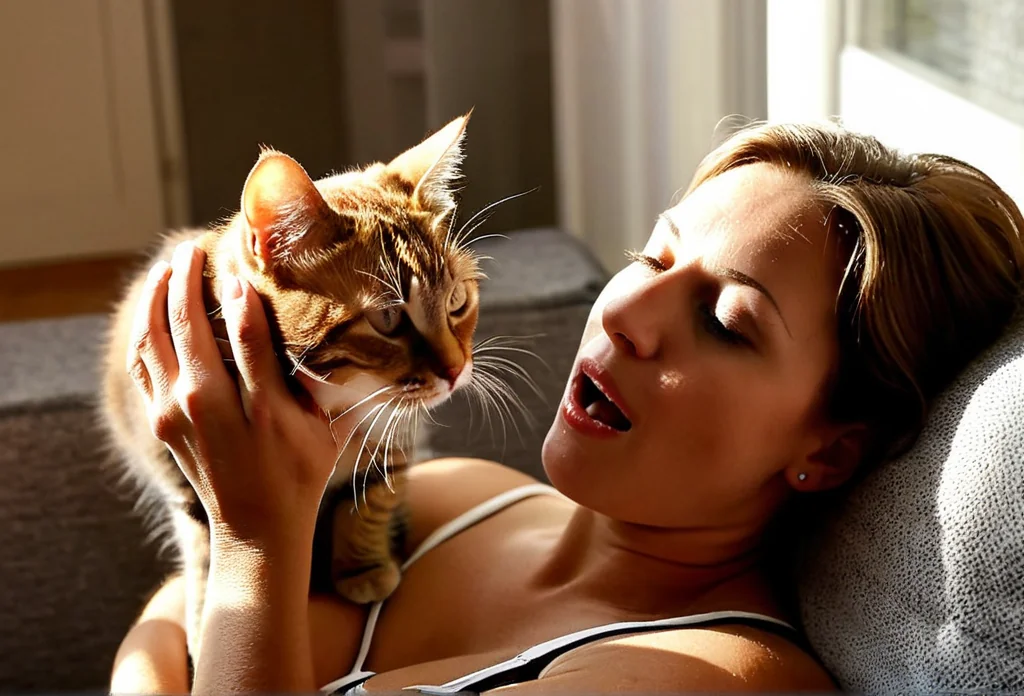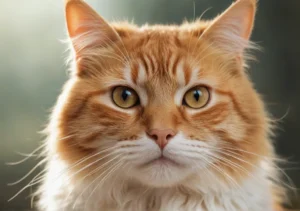Cats are sometimes mysterious creatures, and the strange things they do can leave us puzzled. When your feline friend takes a moment to spit on you, it can feel confusing and even a little alarming.
Cats may spit or hiss as a way to communicate discomfort or irritation. It’s their instinctive way of expressing that something isn’t right, be it stress, fear, or even a health issue. But there’s more to that seemingly bizarre behavior; keep reading to uncover the layers beneath your cat’s quirky antics!

What Does Spitting Mean in Cats
Spitting is often a clear sign that your cat’s feeling threatened or overwhelmed. Unlike hissing, which can simply be a warning, spitting usually indicates a more intense emotional response. It’s a sharp vocalization that can express fear, irritation, or a strong desire to be left alone. This behavior is part of their instinctual toolkit; when a cat feels cornered or unwell, they may spit as a way to assert themselves and discourage whatever’s threatening them.
Cats communicate through a rich tapestry of sounds and body language. For instance, if combined with other signs like a puffed-up tail, flattened ears, or a crouched posture, spitting can signify that your feline isn’t just annoyed but genuinely scared. If your cat suddenly spits at you, take a moment to observe the situation closely—are there other pets around? Is loud noise happening nearby? Recognizing the surrounding triggers can give you crucial context about why your kitty’s acting this way.
Always remember, though, that persistent spitting might indicate underlying stress or illness. If it happens frequently, consider having a chat with your veterinarian to rule out health issues.
Is My Cat Afraid or Anxious
Fear and anxiety can manifest in various ways in cats. Spitting might just be the tip of the iceberg when your cat’s feeling uneasy. Common triggers include loud noises, unfamiliar environments, and the presence of other animals or people. Each of these scenarios can cause your cat to resort to spitting as a defensive mechanism.
When a cat is scared, they might also exhibit behaviors like:
- Hiding: Seeking refuge in a quiet spot.
- Pacing: Walking in circles or back and forth restlessly.
- Vocalizing: This could range from soft whines to loud meows.
- Aggression: If pushed further, a scared cat might resort to biting or scratching.
Recognizing these signs can help you understand your cat’s state of mind. For instance, if your furball’s been recently introduced to a new pet, it’s perfectly normal for their anxiety levels to spike. Creating a safe space with familiar toys or cozy bedding can ease their nerves.
For additional guidance on how to help an anxious cat, check out the resources provided by the ASPCA: ASPCA Cat Behavior.
Could There Be a Health Issue
If your cat just spit on you, it might be a clear signal that something’s not right. Spitting, often mistaken for a harmless behavior, can actually indicate underlying health issues. For instance, dental problems like * gingivitis or loose teeth* can cause discomfort and may lead to this unusual reaction. Cats in pain may respond defensively, which could manifest as spitting.
Gastrointestinal issues , such as nausea or upset stomach, might also play a role. If your cat’s feeling queasy, it may express its discomfort in surprising ways.
To get to the bottom of the situation, keep an eye out for other signs of a health issue:
- Changes in appetite
- Increased aggression or irritability
- Frequent vocalizations
- Grooming changes or unkept fur
If these symptoms persist, a trip to the vet is definitely in order for a thorough check-up.
What Environmental Factors Could Be at Play
A cat’s environment can deeply influence their behavior, including unexpected actions like spitting. Stressors in their surroundings, such as changes in routine, new pets, or loud noises, can lead to anxiety.
Consider these potential environmental factors:
- New pets or humans entering the household
- Changes in routine, like altered feeding times or new schedules
- Loud noises from construction or other external disturbances
- Inadequate hiding spots or territorial disputes among pets
- Lack of play or mental stimulation resulting in frustration
Understanding these triggers is crucial. Try to create a safe space for your cat where it can retreat when feeling overwhelmed. Adding vertical spaces like cat trees or shelves can also help alleviate stress by giving them more control over their territory.
Additionally, using calming products such as Feliway diffusers can make a noticeable difference. These products mimic natural cat pheromones that can help create a more relaxed environment, reducing stress-induced behaviors like spitting. For more insights on cat behavior and environmental enrichment, check out the resources provided by the ASPCA here.
Do Certain Breeds Spit More
Curiously, some cat breeds are more prone to spitting than others. Siamese and Bengal cats, known for their vocal and energetic personalities, might express themselves with more spitting, especially when they’re feeling particularly playful or agitated. These breeds tend to have a strong attachment to their owners and can communicate frustration or overexcitement through such behaviors.
Traits Influencing Spitting
- Vocalization: Breeds like the Siamese are naturally loud and expressive, which could extend to spitting as a vocal output.
- Activity Level: Energetic cats, such as Bengals, may feel overwhelmed during play, leading to sudden spitting.
- Sensitivity: Some breeds have higher sensitivity to touch; if they’re overstimulated, spitting could be a signaling behavior.
Understanding your cat’s breed traits can provide insight into their behavior. Ultimately, it’s all about how your kitty communicates.
How Should I Respond to My Cat
If your cat just spat on you, it’s not an act of aggression but rather a way of expressing their feelings. It’s essential to recognize their emotional state.
Start by observing the situation. Was there something that startled them or made them uneasy? If you notice signs of anxiety, consider creating a more calming environment. You might want to give them some space to chill out.
Here are a few tips on how to handle it:
- Stay Calm: Avoid yelling or reacting dramatically; your cat might take it as a sign to be more defensive.
- Assess the Mood: If they’re agitated, give them a quiet space and resources to decompress.
- Use Positive Reinforcement: When they settle down, reward them with treats or a gentle stroke to reinforce calm behavior.
- Regular Play: Schedule interactive play times to help channel their energy positively.
- Consult a Vet: If spitting occurs frequently, consider discussing it with a vet. They could check for any underlying health issues.
Keep in mind that communication goes both ways. To strengthen your bond, listen to what your cat is trying to tell you. For more on cat behavior, the ASPCA has some great resources here.
What Are Other Signs of Discontent
Cats can be pretty subtle when they’re feeling off, so spotting additional signs of discontent can really help you connect with your feline friend. If your cat just spat at you, there’s likely more to the story. Here are some common indicators that your kitty might be upset:
- Tail Position: A flicking or puffed-up tail usually signals agitation.
- Ears Back: Flattened ears indicate discomfort or fear.
- Vocalizations: Unusual growls, hisses, or yowls can mean trouble.
- Body Language: A crouched posture or quick, jerky movements may suggest anxiety.
- Hiding: If your cat runs for cover, it’s a strong sign they want space.
- Loss of Appetite: Disinterest in food can signal stress or illness.
Understanding these behaviors can help you create a calmer environment. If you notice a pattern in your cat’s discontent, it might be time to re-evaluate their surroundings or routine.
Fun Facts About Cat Communication
It’s fascinating how much cats have to say without uttering a single meow or hiss. Spitting is just one quirky vocalization in their communication toolkit. Here are some intriguing insights into how cats express themselves:
- Pheromones: Cats communicate a lot through scent. They have scent glands around their face, paws, and tail, which they use to mark their territory or say “I’m uncomfortable.”
- Chirps and Trills: Instead of just meows, cats often use chirps to get your attention, especially when they’re excited or trying to mimic bird sounds.
- Slow Blinking: When your cat slowly blinks at you, it’s a sign of trust and affection. You can return the gesture to strengthen your bond.
- Kneading: This cute behavior, where cats push their paws in and out against soft surfaces, is a leftover from kittenhood. It indicates comfort and happiness.
- Tail Communication: A raised tail typically suggests a happy cat, whereas a low, twitching tail could mean they’re feeling threatened.
For more details about feline communication, you might want to check out the comprehensive resource at The Spruce Pets on Cat Communication.
Understanding these aspects of cat behavior helps deepen your relationship with your pet and fosters a happier home environment.
Alex, a passionate animal lover, has experience in training and understanding animal behavior. As a proud pet parent to two dogs and three cats, he founded AnimalReport.net to share insights from animal experts and expand his knowledge of the animal kingdom.




